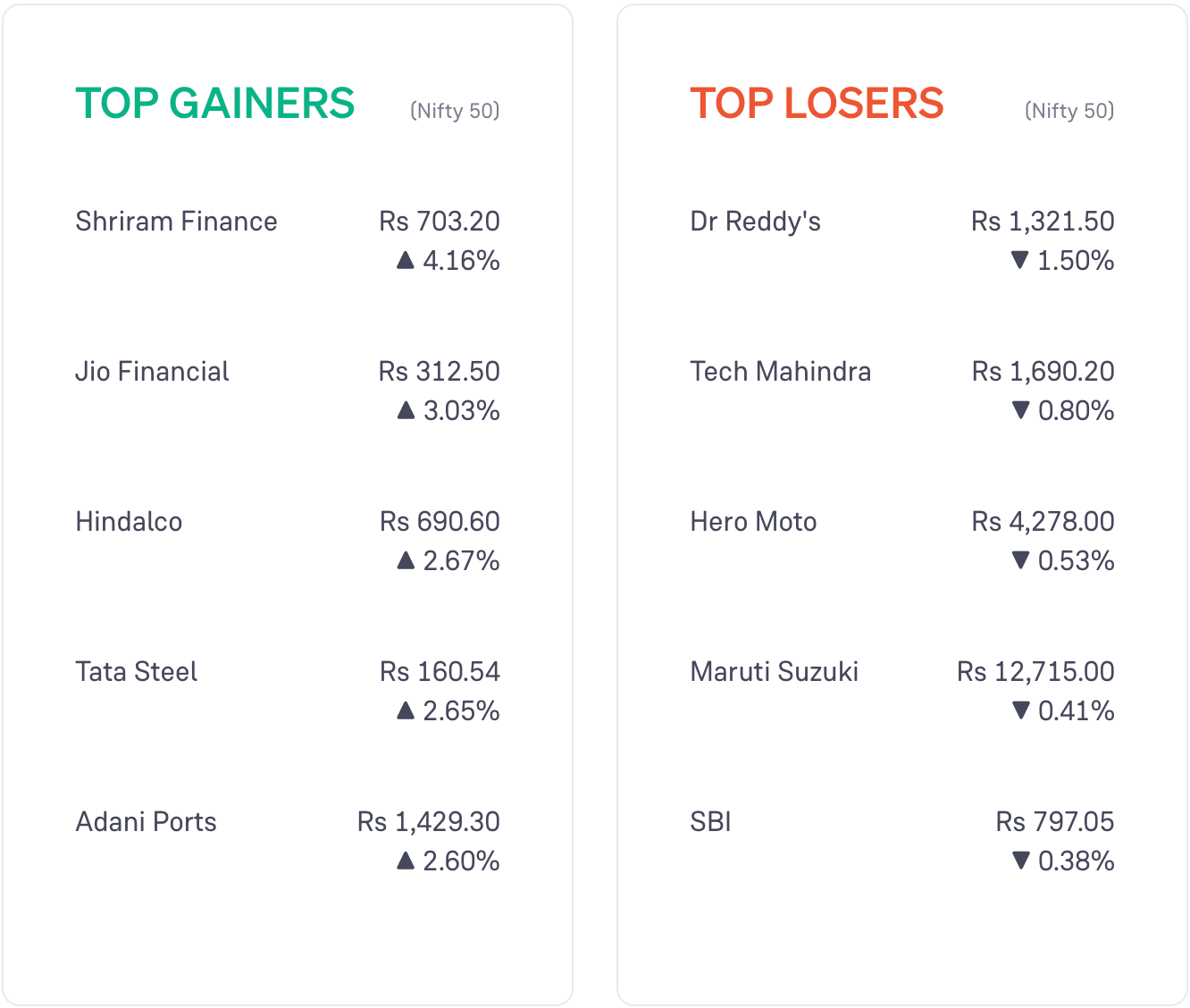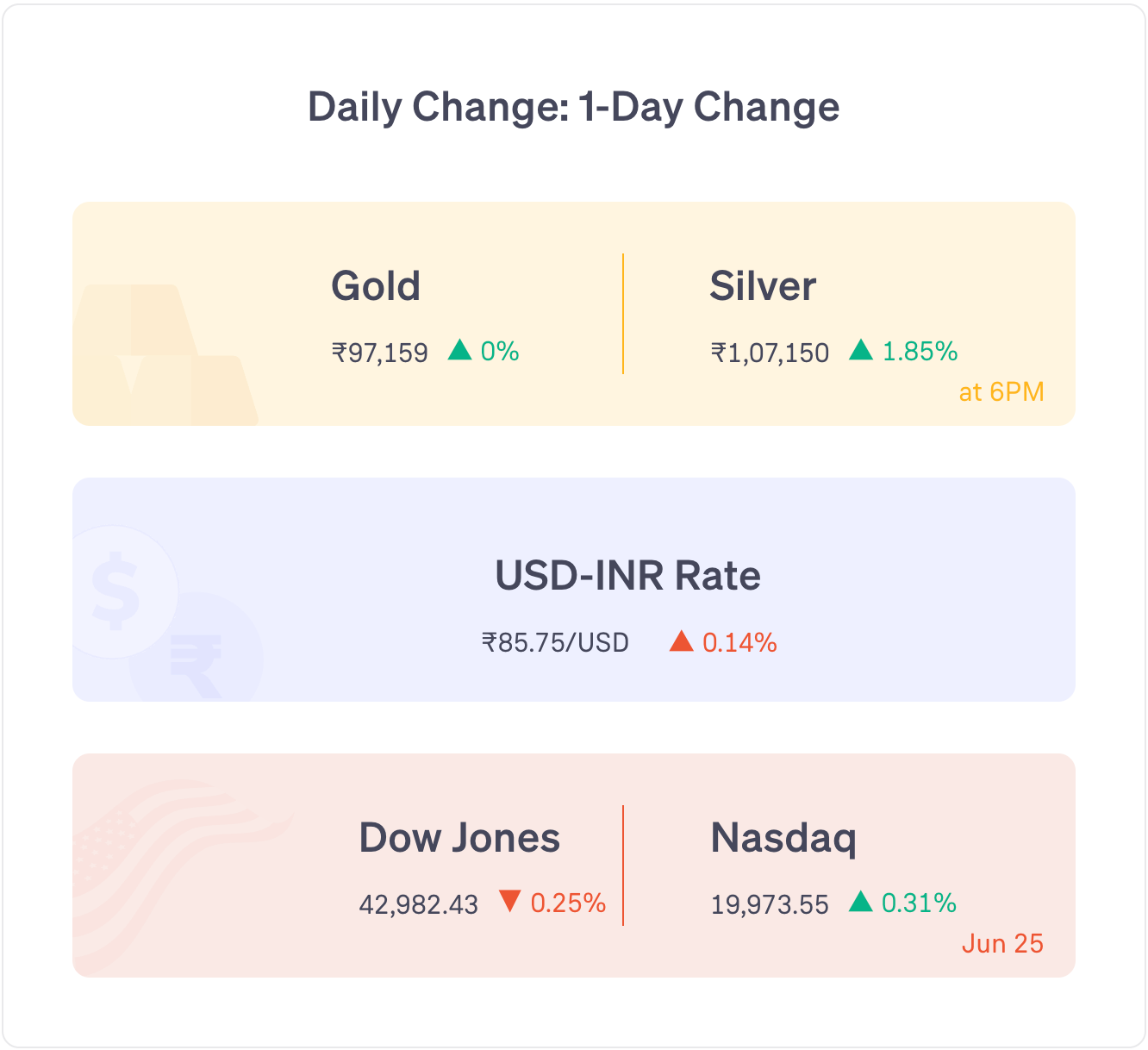Markets opened above yesterday’s closing point.
Nifty 50 was volatile in the first half of the day. It rose in the second half.
Metal stocks and oil and gas stocks rose the most today. Media stocks and realty stocks fell the most.
Global markets: US and Asian markets closed in red. Most European markets closed in green.
News
Pine Labs has filed its draft red herring prospectus (DRHP) with SEBI for a Rs 2,600 crore IPO.
RBI's holding of government bonds rose to a record high in March. RBI now holds 12.78% of all outstanding government bonds (it held 10.55% in Dec 2024).
India’s engineering goods exports fell 0.82% year-on-year to $9.89 billion in May: EEPC.
Kalpataru IPO was subscribed 2.26 times. Retail subscription: 1.29 times. IPO closed for subscription.
Ellenbarrie Industrial Gases IPO was subscribed 22.19 times. Retail subscription: 2.14 times. IPO closed for subscription.
HDB Financial Services IPO was subscribed 1.16 times. Retail subscription: 0.64 times. IPO closes tomorrow (27 June).
Sambhav Steel Tubes IPO was subscribed 1.76 times. Retail subscription: 1.84 times. IPO closes tomorrow (27 June).
Stocks Updates
JNestle: board approved a 1:1 bonus issue of shares. Record date: yet to be announced.
M&M: will sell its entire stakes in Mahindra Defence Systems, Mahindra Telephonics Integrated Systems, and Mahindra Emirates Vehicle Armouring FZ LLC to its wholly owned subsidiary Mahindra Advanced Technologies by end of Sept 2025.
Tata Steel: acquired shares worth Rs 1,562.54 crore in its Singapore-based subsidiary, T Steel Holdings Pte, as part of its ongoing infusion of funds. The company also received a show cause notice regarding input tax credit for FY19 to FY21, with a Rs 890.52 crore demand. The company plans to contest the notice.
JSW Energy: company subsidiary, Energizent Power, signed a power purchase agreement with NHPC for a 300 MW solar-wind hybrid capacity, with a 25-year supply term. The project, located in Rajasthan and Andhra Pradesh, is expected to be commissioned within 24 months.
Hitachi Energy: received an order from Power Grid Corp to supply 30 units of 765 kV transformers.
BSE: received a penalty of Rs 25 lakh from SEBI for violating regulations during an inspection for the period 1 Feb 2021 to 30 Sept 2022.
Bank of India: board approved issuing long term infra bonds of up to Rs 20,000 crore in FY 2025-26.
Word of the Day
Book Building
It is a part of the IPO process where the price of the shares is determined
Here, the price is determined by investor demand.
Instead of a fixed price, the company sets a price range, called a price band.
When the IPO opens for subscription, investors place bids, mentioning how many shares they want and at what price within this band.
All these bids are recorded in a ‘book.’
After the IPO closes for subscription, the final price is set (cut-off price) based on the demand from investors.
Investors who bid above the cut-off price are eligible for the allotment.
6 Day Course
Theme: when to buy and sell
Day 4: Thursday
The ‘when to buy’ differs based on investment style:
Value investors will buy only when the stock is fairly valued or undervalued.
The challenge is that good companies’ stocks are almost always overvalued.
Value investors wait for times like recessions when all stocks fall to historic lows.
On the other hand, growth style investors want high growth. If they identify a stock as being a fast-growing stock, they buy it even at a higher valuation.
For such investors, growth of revenues, markets, earnings, etc, is far more valid than valuation.
When it comes to selling, value investors often start selling when the share becomes overvalued. Or they hold on through the overvalued periods.
Growth investors usually exit the moment the share loses its fast-growth of revenues, market size, earnings, etc.
Featured Question
Q. “Many companies today are trading as penny stocks. Initially, during their IPO, they are listed with a price band that is typically not very low. However, over time, due to various factors, the stock price may fall significantly and turn into a penny stock. Is this how most penny stocks are formed?”
Yes, mostly.
Penny stocks are mostly companies that were once bigger and have fallen.
The reasons behind this could be numerous.
Very few companies IPO as penny stocks. Most always start off with much higher share prices and then fall.
Not just poor performance (revenues, earnings, etc), many times companies become smaller because of demergers and acquisitions of subsidiaries.
In the US, penny stocks are classified as anything less than $1.
In India, there is no clear or official definition of penny stock.
'Shares with a price less than Rs 10' is a commonly accepted definition of penny stocks in India.
Some even consider Rs 20 as the threshold for this.
Did you like this edition?
Leave a feedback here!






